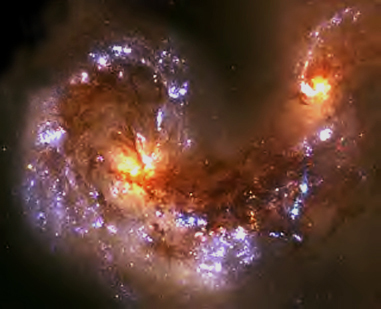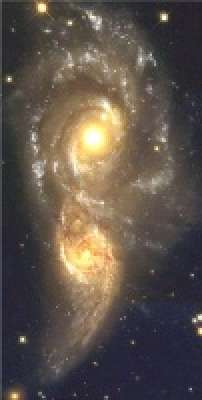
Home Page
|
 |
Tony's Astronomy
|
|
|
 |
What's the Universe Made Of?
New discoveries in space, such as evidence of a mysterious "dark energy" expanding the Universe and the apparent ubiquity of black holes of all sizes, have placed us on the verge of a scientific breakthrough that will revolutionize the field of physics. The moment is analogous to the dawn of the 20th century, when the discovery of the electron and other phenomena set the stage for the new paradigm of quantum physics and general relativity. |
|
What's the Universe Made Of?
The current estimate is that the Universe is 65% dark energy, 30% dark matter, and 5% ordinary matter -- the kind of stuff that stars, planets, and humans are made of. Gravity wave missions such as the Laser Interferometry Space Antenna (LISA) may be able to detect the rumbling of the Big Bang, ripples in the fabric of space caused by that great explosion. Because gravity waves do not interact with matter, those initial gravity waves produced by the Big Bang could still be percolating through the Universe for us to detect. If so, LISA and follow-up missions could use these waves to determine the total mass content of the Universe -- for the frequency of the waves depend on the density of matter.
But what is dark matter? There are, naturally, many theories... and they all may be both correct and incorrect. That is, dark matter need not be one type of matter. Dark matter could be a combination of dim chunks of ordinary matter plus many forms of exotic matter plus great abundances of miniscule bits of matter. Scientists aren't fussy. They are merely looking for the unseen mass providing the gravitational glue that keeps galaxies and galaxy clusters from flying apart -- for the amount of ordinary, visible matter does not provide enough mass to keep things in place.
Case 1
|
|
Expanding Universe
The universe has existed for only about 10 billion years. It began in a very hot, dense, contracted state, and has been expanding ever since. This chapter discusses the beginning of the universe (the so-called big bang), the ensuing expansion, the shape of the universe, and the question of whether the universe will someday recollapse, or whether it will keep expanding forever. Experimental evidence suggests that the universe is isotropic. If it has elliptic geometry it will recollapse someday, if it has hyperbolic geometry it will keep expanding forever, and if its geometry is Euclidean it will expand forever, but just barely (the rate of expansion approaches zero). Current evidence hints that the universe has hyperbolic geometry and will expand forever, but no one really knows for sure.
The expansion of the Universe does not mean that there is a direction in which the Universe is expanding. There is no "center" of the Universe from which all the galaxies came from. Rather, ALL space isexpanding in all directions. Imagine that the Universe is an infinitely large rubber sheet, and something is causing the rubber sheet to stretchAll of us living on the rubber sheet would notice that it is stretching but there is no center to the stretching - everything is getting further away from everything else.
|
|
Galaxies range from several thousand to one hundred thousand light years in diameter and contain billions of stars. There are three main classes of galaxies, classified by Hubble: Ellipticals, Spirals, and Barred Spirals. There are two others: irregular and lenticular.
Elliptical
Of all the types of galaxies, these are the least attractive. They are rounded objects and central condensed. Like their name implies they are elliptical in shape ranging from a circle to as elliptical as a football. Ellipticals range greatly in size. They contain no young stars because ellipticals contain little to no gas. Most elliptical galxies are old and reddish in color.
Spiral
Spiral Galaxies are young beauties, a high contrast to their elliptical relatives. What defines them is the prescence of spiral arms, usually two in number, which wrap around the centers. The arms lie on a flat disk so a face-on and edge on view is very different. The spiral arms contain young hot stars, nebulae, and intersteller dust. Hot stars are blue in color so the spiral arms also appear blue. Spiral galaxies contain both Population I and Population II stars. The Population II are found in the center so spiral galaxies are in a sense ellipticals with arms.
Barred Spirals
Barred Spirals differ from Spirals in that the spiral arms start at the end of a bar rather then at the galactic nucleus.
Also in barred spirals there is little mass in the center ofterwise the bar would end up being wrapped up just like a spiral. Instead most of the mass lies at the end of the bar sort of like a dumbbell.
Irregular
Irregular galaxies are galaxies that don't have any kind of structure. They usually contain many hot blue stars and more gas then spirals. From this it is believed that Irregulars are young galxies and that maybe in middle age they will discover structure. Large irregulars are rare so most irregulars we see are small in size and their brightest stars may be resolved. The most famous irregular galaxies are the Large Magellanic Cloud and the Small Magellanic Cloud seen below as the middle and left image, respectively.
Lenticular
Lenticular galaxies are galaxies that show characteristics between spirals and ellipticals. Lenticular are disks thickest in the middle, like elliptical, but elliptical have rounded edges while lenticular taper toward their outer points. As if they have tried to expand outward into spirals but don't have the material to do it. Lenticulars have more in common with spirals then ellipticals so they are classified S0, a spiral without arms. Like spirals they are rich in dust and gas. They gas is spread out into space in the form of arms that spirals have. But very little of this gas is made into stars, so lenticulars have the spiral arms but not enough stars in these arms to see them.
|
|
When we contemplate the unimaginable vastness of the universe, the incredible diversity and complexity of life on Earth, the sheer tenacity of life to survive, the wonderful beauty of nature, we are filled with a sense of amazement. !3,000,000,000 years or so in the making, and here we are, wondering why.
In this unbelievable universe, with its 100 billion galaxies, each containing 100's of billions of stars, we inhabit a small world circling one ordinary star. One star amongst 10,000,000,000,000,000,000,000.
Link to More Cases
|
 |

